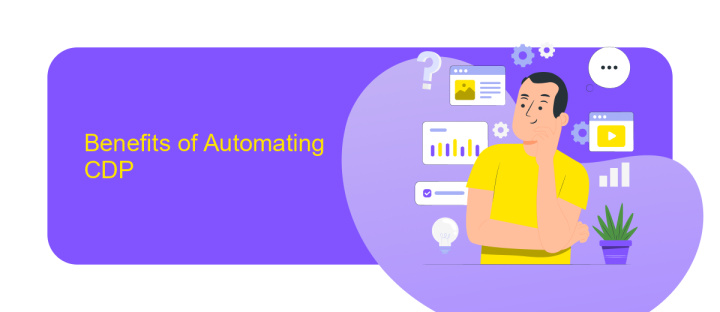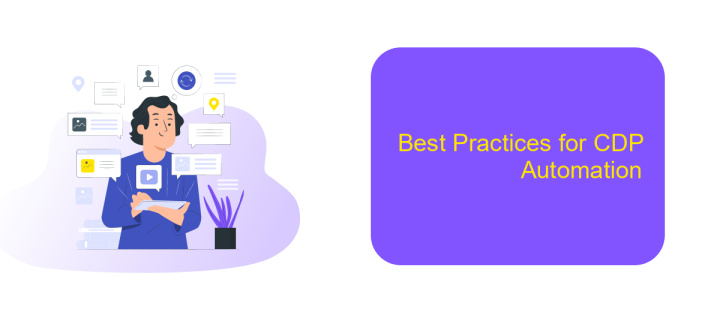Customer Data Platform Automation
In today's digital era, businesses are increasingly relying on data-driven strategies to enhance customer engagement and streamline operations. A Customer Data Platform (CDP) serves as a centralized hub, integrating and managing customer information from various sources. The automation of CDP processes not only improves data accuracy and efficiency but also empowers companies to deliver personalized experiences, driving customer satisfaction and loyalty to new heights.
Customer Data Platform (CDP) Automation Overview
Customer Data Platform (CDP) automation is a transformative approach that enhances the efficiency and effectiveness of data management processes. By automating data collection, integration, and analysis, businesses can unlock deeper insights into customer behavior and preferences. This automation not only reduces manual effort but also minimizes errors, ensuring that data-driven strategies are based on accurate and up-to-date information.
- Streamlined data integration from multiple sources
- Real-time customer insights and analytics
- Automated segmentation and targeting
- Improved data accuracy and consistency
- Enhanced personalization and customer engagement
Implementing CDP automation empowers organizations to deliver personalized experiences at scale, driving customer satisfaction and loyalty. By leveraging advanced technologies such as machine learning and artificial intelligence, businesses can predict customer needs and tailor their offerings accordingly. This proactive approach not only enhances customer relationships but also provides a competitive edge in the ever-evolving digital landscape.
Benefits of Automating CDP

Automating a Customer Data Platform (CDP) can significantly enhance the efficiency and effectiveness of data management processes. By streamlining data collection, integration, and analysis, businesses can gain a comprehensive view of their customers in real time. Automation reduces the manual effort required to consolidate data from various sources, enabling more accurate and timely insights. This empowers marketing teams to deliver personalized experiences, improve customer engagement, and boost overall satisfaction. Furthermore, automation minimizes human errors, ensuring data integrity and reliability, which is crucial for making informed business decisions.
One of the key benefits of automating a CDP is the seamless integration with other platforms and services. Tools like ApiX-Drive facilitate this process by enabling easy setup and management of integrations, allowing businesses to connect their CDP with various marketing, sales, and analytics tools without extensive technical expertise. This connectivity ensures that data flows smoothly across systems, providing a unified customer view. Ultimately, automating a CDP not only saves time and resources but also enhances the agility and responsiveness of a business in a rapidly evolving digital landscape.
Challenges in Automating CDP

Automating a Customer Data Platform (CDP) presents several challenges that organizations must address to ensure seamless integration and functionality. The complexity of data sources and the need for real-time processing demand robust solutions that can adapt to ever-changing business environments. Ensuring data accuracy and consistency across various systems is crucial, as discrepancies can lead to misguided strategies and decisions.
- Data Integration: Integrating diverse data sources into a unified platform is a significant challenge, often requiring custom solutions.
- Scalability: As data volumes grow, maintaining performance and efficiency becomes increasingly difficult.
- Data Privacy: Ensuring compliance with data protection regulations, such as GDPR, is critical to avoid legal repercussions.
- Resource Allocation: Automating processes demands substantial resources, both in terms of technology and skilled personnel.
Overcoming these challenges requires a strategic approach that balances technological innovation with regulatory compliance and resource management. Organizations must invest in scalable solutions and skilled teams to harness the full potential of CDP automation. By doing so, they can improve customer insights and drive more personalized and effective marketing strategies.
Best Practices for CDP Automation

Implementing automation in a Customer Data Platform (CDP) can significantly enhance operational efficiency and data accuracy. To achieve optimal results, it's essential to follow best practices that ensure seamless integration and functionality. Begin by clearly defining your automation goals and aligning them with business objectives to ensure that every automated process adds value.
Next, prioritize data quality and governance. Automation is only as effective as the data it processes, so maintaining clean, accurate, and up-to-date data is crucial. Implement robust data validation and cleansing processes to prevent errors from propagating through automated workflows.
- Regularly review and update automation rules to adapt to changing business needs.
- Ensure cross-departmental collaboration to align automation efforts with overall business strategies.
- Utilize scalable automation tools that can grow with your business.
- Continuously monitor automated processes to identify and rectify any inefficiencies.
Finally, invest in training and support for your team to maximize the potential of CDP automation. Empower employees with the knowledge and resources they need to effectively manage and optimize automated processes, ensuring long-term success and adaptability in a dynamic business environment.
- Automate the work of an online store or landing
- Empower through integration
- Don't spend money on programmers and integrators
- Save time by automating routine tasks
Future of CDP Automation
The future of Customer Data Platform (CDP) automation is poised to revolutionize how businesses manage and utilize customer data. With advances in machine learning and artificial intelligence, CDPs will become increasingly adept at predicting customer behavior and personalizing interactions in real-time. This evolution will enable companies to deliver highly targeted marketing campaigns and improve customer experiences, driving greater loyalty and retention. As data privacy regulations become more stringent, automated CDPs will also incorporate robust security measures to ensure compliance and protect customer information.
Integration capabilities will further enhance the functionality of CDPs, allowing seamless connectivity with various marketing tools and platforms. Services like ApiX-Drive will play a crucial role in this ecosystem by enabling businesses to easily configure integrations without extensive technical expertise. By automating data flow between systems, companies can achieve a holistic view of their customers and streamline operations. As a result, the future of CDP automation promises to empower businesses with actionable insights, fostering innovation and growth in an ever-evolving digital landscape.
FAQ
What is a Customer Data Platform (CDP) and how does it work?
How can automation enhance the functionality of a CDP?
What are the benefits of integrating a CDP with other marketing tools?
How can businesses implement automation in their CDP systems?
What challenges might businesses face when automating their CDP, and how can they overcome them?
Apix-Drive is a universal tool that will quickly streamline any workflow, freeing you from routine and possible financial losses. Try ApiX-Drive in action and see how useful it is for you personally. In the meantime, when you are setting up connections between systems, think about where you are investing your free time, because now you will have much more of it.


